#Church of San Clemente
Explore tagged Tumblr posts
Text
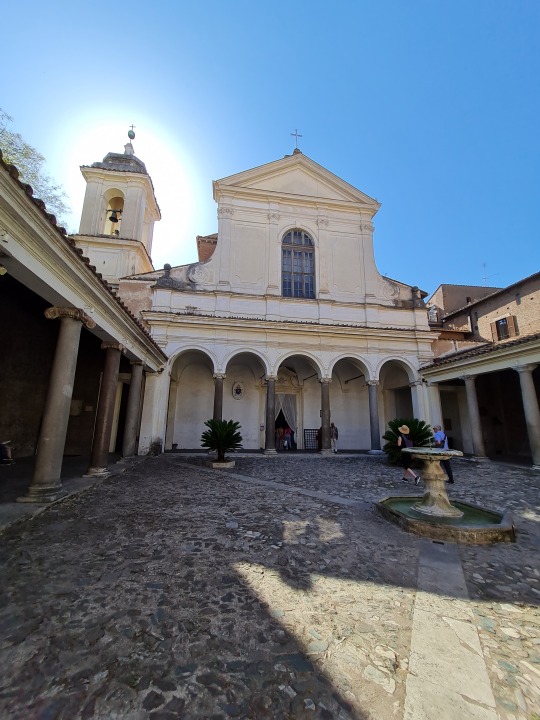
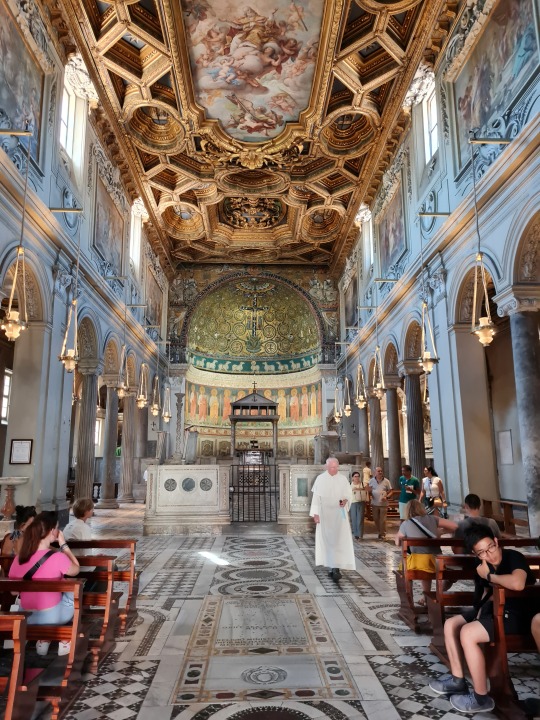
Basilica di San Clemente al Laterano in Rome, Italy
Under the basilica that stems from the 12th century, there are two more layers that you are able to visit: a basilica from the 4th century and a mithraeum from the 2th century.
In my opinion the most interesting church Rome has to offer.
#basilica#san clemente#rome#rome italy#italy#italia#italian architecture#architecture#history#italian history#roman history#ancient rome#church#catholic church#mithraeum#mithras#romanesque#archaeology#roman archaeology#culture#travel#traveling#photography#wanderlust#travel tips#travel blog#travel destinations#explore#travel photography#art
119 notes
·
View notes
Text
Our tour guide around Rome today was a historian, and one of the most fantastic people I've been able to meet on the trip and enthusiastic about history and his research. So much fun to walk around with! My pictures are all a bit meh imo. But I'll post some a bit later.
#The tour guides are handling my mother very well. Its impressive honestly.#She kept going on and on about Jerusalem and the Bible and trying to contradict him with some things. He typically just Yes Anded her#into a topic she didnt even notice was not related. it was so skilled lol. And then if we could; bro and i would rescue him with a question#of whatever was around. And oh man there was so much around.#We went to the Church of San Clemente and Aahhhhh that was SO cool. not only a beautiful chirch (god i hate christianity for destroying Rom#but also ahhhhhhrhhg the marble floor was so beautiful. And we went down into the 4th and 1at century floors. SO cool.#10/10 day. Absolutely wonderful!
5 notes
·
View notes
Text






#ai photography#design#ai generated#ai image#interior design#stable diffusion#romanic#marble#church#columns#building#architecture#roman architecture#roman#ancient#altar
5 notes
·
View notes
Text

‘Secret Room’ Decorated by Michelangelo to Open to the Public in Italy
He’s known for his colossal works, such as the statue of David, the floor-to-ceiling frescoes of the Sistine Chapel, and the dome of St. Peter’s which dominates the Rome skyline.
But it’s Michelangelo Buonarroti’s less bombastic work that’s on display to the public for the first time in the artist’s “secret room” in Florence.
The tiny space sits beneath the Medici Chapels in Florence, where Michelangelo sculpted intricate tombs for members of the Medici family behind the church of San Lorenzo in the Sagrestia Nuova, or New Sacristry.
In 1975, during works to create a new exit for the venue, a restorer carrying out cleaning experiments uncovered multiple drawings of human figures under two layers of plaster in a corridor underneath the sacristy which had been used to store coal.
The narrow space is 33 feet long, 10 wide and eight feet high.
The figures – sketched in charcoal and sanguine (rust-colored chalk or crayon), often one on top of the other, and of different sizes – were attributed to Michelangelo by Paolo Dal Poggetto, the former director of the Medici Chapels.

It is believed that the artist hid in the claustrophobic space for several weeks in 1530 when pope Clement VII – a member of the Medici family, who had recently returned to power in Florence, having been kicked out by a republican government for whom Michelangelo had worked – ordered his death. The death sentence was rescinded after two months, and Michelangelo returned to work in Florence, before moving to Rome four years later.
It’s believed the drawings are sketches for future works, including the legs of one of the statues in the New Sacristy.
“This place grants today’s visitors the unique experience of being able to come into direct contact not only with the creative process of the maestro, but also with the perception of the formation of his myth as a divine artist,” said Francesca de Luca, curator of the Museum of the Medici Chapels, in a statement. Paola D’Agostino, director of the Bargello Museums, which the chapels are part of, said the restoration has been “time-consuming, constant and painstaking work.”
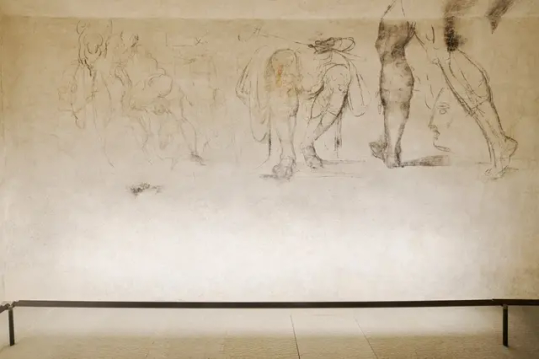
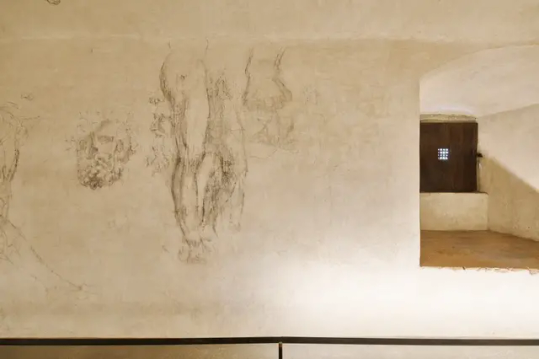
The space has never been open regularly to the public before, but will open for visits on November 15 to highly limited numbers in order to preserve the drawings. A maximum of 100 people will be able to visit per week, in groups of four, and 15-minute visits will take place every day except Tuesdays and Sundays.
By Julia Buckley.
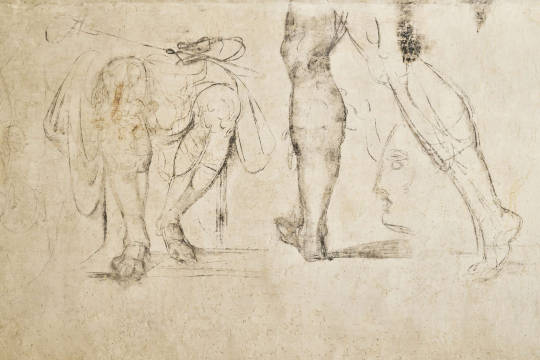

#Michelangelo#‘Secret Room’ Decorated by Michelangelo to Open to the Public in Italy#Medici Chapels in Florence#italian artist#charcoal drawing#sanguine drawing#art#artist#art work#art world#art news
26 notes
·
View notes
Text
SAINT OF THE DAY (August 23)

On August 23, the church celebrates the first saint of the New World, St. Rose of Lima.
Isabel Flores de Oliva was born on 20 April 1586 in Lima, Peru, daughter of Gaspar Flores and Maria de Oliva.
She was baptized in the parish of San Sebastián in Lima by the priest, Fr. Antonio Polanco.
She was confirmed in the village of Quives de Manos by the then Archbishop of Lima, St. Toribius de Mogrovejo.
At a very young age, she chose to consecrate her life to God. She practiced very intense prayer and penance daily, sometimes depriving herself of food and sleep.
She joined the Third Order of St. Dominic and lived in a little hut in her parents' garden, working to help support them.
She was ill for the last three years of her life.
She died at the age of 31 on 24 August 1617, Feast of St. Bartholomew, as she herself prophesied.
Rose was beatified by Pope Clement IX on 25 April 1667. She was canonized by Pope Clement X on 12 April 1671.
She is the patron saint of embroiderers, gardeners, florists, people who are harassed for their piety, and those suffering from family problems.
She is also the patroness of the Americas, the indigenous people of the Americas, and of Peru, India, and the Philippines.
Her shrine, alongside those of her friends, St. Martin de Porres and St. John Masias, is located inside the convent of St. Dominic in Lima.
4 notes
·
View notes
Text
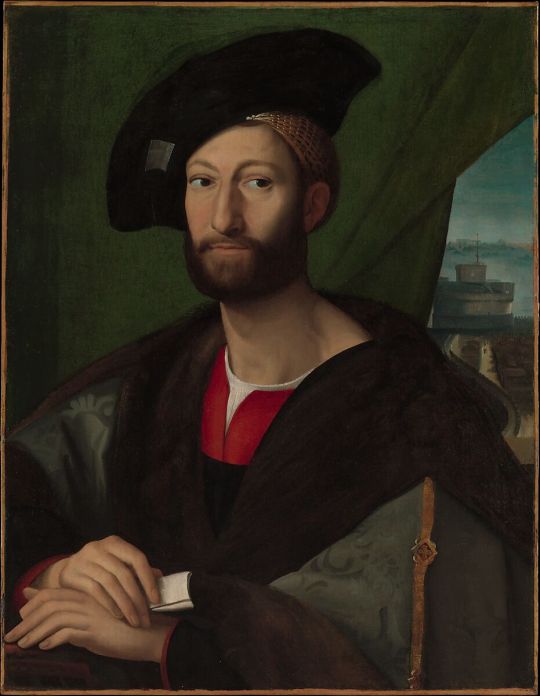
Giuliano de' Medici Duke of Nemours
Artist: After Raphael
Giuliano di Lorenzo de' Medici KG (12 March 1479 – 17 March 1516) was an Italian nobleman, the third son of Lorenzo the Magnificent, and a ruler of Florence.
Born in Florence, he was raised with his brothers Piero and Giovanni di Lorenzo de' Medici, who became Pope Leo X; as well as his cousin Giulio de' Medici, who became Pope Clement VII.
His older brother Piero was briefly the ruler of Florence after Lorenzo's death, until the republican faction drove out the Medici in 1494. Giuliano moved therefore to Venice. The Medici family was restored to power after the Holy League drove the French forces that had supported the Florentine republicans from Italy. This effort was headed by Spain with the support of Pope Julius II. Giuliano reigned in Florence following his brother's election to the papacy in 1513, until he died in 1516.
He married Filiberta (1498–1524), daughter of Philip II, Duke of Savoy, on 22 February 1515 at the court of France, thanks to the intercession of his brother Giovanni, now pope as Leo X, in the same year that King Francis I of France (Filiberta's nephew) invested him with the title Duke of Nemours (which had recently reverted once again to the French crown) on the occasion. The French were apparently grooming him for the throne of Naples (in which the French maintained a historical interest), when Giuliano died prematurely. He was succeeded in Florence by his nephew Lorenzo II de' Medici.
Giuliano left a single illegitimate son, Ippolito de' Medici, who became a cardinal.
His portrait, painted in Rome by Raphael (a painter favored by Leo), shows Rome's Castel Sant'Angelo behind a curtain. (A studio version is at the Metropolitan Museum of Art.)
Giuliano's tomb in the Medici Chapel of the Church of San Lorenzo, Florence, is ornamented with the Night and Day of Michelangelo, along with a statue of Giuliano by Michelangelo. He shares an identical common name (Giuliano de' Medici) with his uncle Giuliano di Piero de' Medici, whose tomb is also in the Medici Chapel and who is famous for having been assassinated in the Pazzi Conspiracy.
#portrait#raphael#giuliano de medici#italian#duke of nemours#italian nobleman#italian nobility#italian culture#medici family#castel sant'angelo#drapery
5 notes
·
View notes
Text

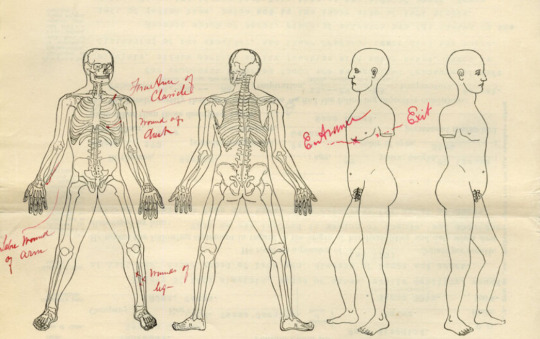
2nd Lieutenant Santos Cadena details the injuries he received in the American Civil War, the Mexican Reform War, and the Second Franco-Mexican War. Affidavit (5/4/1898) and diagram (3/28/1904) from his Civil War pension file.
Record Group 15: Records of the Department of Veterans Affairs
Series: Case Files of Approved Pension Applications of Widows and Other Dependents of the Army and Navy Who Served Mainly in the Civil War and the War With Spain
Image description: Four diagrams of a man, two showing the skeleton and two showing the outside of the body (without arms). Marked in red ink are “Fracture of Clavicle,” “Wound of Chest,” “Sabre Wound of Arm,” “Wounds of leg,” and entrance and exit of the chest wound.
Transcription:
GENERAL AFFIDAVIT.
STATE OF Texas, COUNTY OF Duval ss:
In the matter of Santos Cadena - late Co “B” 2nd Tex, Cavly Vols,
ON THIS 4th. day of May, A.D. 1898., personally appeared before me, a Notary Public in and for the aforesaid County and State, duly authorized to administer oaths Santos Cadena, aged 68 years, a resident of Rancho Salado, in the County of Starr and State of Texas, who, being duly sworn, declares in relation to aforesaid claim as follows:
I received a gunshot wound of the left nipple or chest in front of Matamoros in the year 1866 under the command of General Mariano Escobedo, of the Mexican Liberal Army,
I received a Gunshot wound in the left leg in year 1860 in a battle at Gunajuata Mexico, with General Jose Maria. J. Carabajal, of the Mexican Liberal Army,
I received a Saber cut of the left arm in the action of Sialo. West of Guanajuata Mexico, under command of General Carabajal of the Mexican Liberal army,
I had my collar bone broken in the service of the United States near La Trinidad Ranch in Nueces County Texas, in the year 1864 I was a second Lieutenant and was sent out by Colonel J L. Naynes, of the 2nd. Texas Cavalry Volunteers to get some horses for the command and in running the Horses to take them to the pens my horse fell and broke my collar bone, None of the foregoing wounds were caused by Viscious habits,
The Gunshot wound in left nipple, and the Gunshot wound in left leg and the saber cut in left arm were received by my while I was in the Mexican Army, in 1860 I was fighting for Mexico against the Reacitionary or Church party in Mexico, and in 1866 I was fighting against the Imperialists who had invaded my country, I am a Mexican by birth but am an American Citizen,
He further declares that he has [“no” crossed out] interest in said case and is [“not” crossed out] concerned in its prosecution. He being the applicant.
X [signed] Clemente Pompa
X [signed Imalio[?] Perez
His
Santos X Cadena
Mark
NOTE.- In the execution of evidence, whenever a witness signs by X mark, two persons WHO CAN WRITE, MUST attest the signature by signing their names opposite.
[circular stamp]
PENSION
US
OFFICE
MAY 9 1898
[end stamp]
[along left margin]
The foregoing was prepared for typewriting from the statements of the witness in his presence and from my oral statements then made, said oral statements were made to Jas. O. Luby, Notary Public Duval County Texas, at his office in San diego said County and State, May 4th. 1868. And did not use and was not aided or prompted by any printed statement or recital, prepared or dictated by any other per so
#archivesgov#May 4#1898#1800s#March 28#1904#1900s#military#U.S. Civil War#Guerra de Reforma#Segunda intervención francesa en México#injuries
27 notes
·
View notes
Text
7 notes
·
View notes
Photo

Lawrence Alma-Tadema - Interior of the church of San Clemente, Rome
19 notes
·
View notes
Text

























We started off the morning by going to visit the Colosseum. It was hard to get through all of the people because there was also a marathon going on and the streets were closed. Eventually, we were able to get inside and were able to see all of the cool sights and take pictures with them. Afterwards, we went to the 3 layer church, San Clemente, and walked around in there which was very intriguing and saw the physical “layers” that show the story behind the church and what role it plays in the area. Lastly, we went to see Trajan's and Augustus’s forums which provided a great view and a fun experience to really dive deep into the understanding the monument and why it was salvaged. Today was a fun day and we're glad we were able to learn even more about the breathtaking Roman architecture and its history in the region.
-Nicco and Angel
2 notes
·
View notes
Text
Day 6 in Rome
This was our last day before flying to Germany, but it was even lower-key than the previous day!
We had booked entry to San Clemente for 11am. The church was built in the 1200s and doesn't require a ticket to enter. But it was built on top of a church from 392AD, which in turn was built on top of a Mithraic temple and some other ancient Roman buildings, and the underground parts do require a ticket.
It was really interesting, and of course much cooler underground. I had been there once before, but Wife had not, and we really enjoyed it. I especially liked the water gushing out of a spring that had been in a building in ancient Rome. Some people had indoor running water! Afterwards we sat for a bit in the church (it was so hot out that it was even hot in the church) admiring the mosaics. I liked the sheep.
Then we headed out. It was hot, so we went to Fassi, the gelateria we'd passed on the tram the previous evening. It's kind of an Institution. They must own the building, because it's a huge (air conditioned!) space. It was founded in the 1880s, I think. We went all-out: we each ordered, instead of a paper "coppetta" (gelato cup), a fancy glass goblet with four flavors of gelato, whipped cream, and an optional crispy long cylindrical cookie. The flavors I chose were lemon (made with lemons from a specific region with a certified geographic indication) and banana sorbets and pistachio and stracciatella gelatos. We ate there, of course. Very delicious, very refreshing, and very definitely the most gelato I've ever eaten in one sitting!
Then we got a quick, light lunch in a hotel restaurant and went back to our hotel to rest/get out of the heat. I started packing and checked in for the flight the next morning.
We left a little after 5pm to look for an aperitivo, but it was very hot out and we weren't sure where to go. We ended up at the Chiostro di Bramante, which is now a museum. We didn't go into the exhibition, but had a glass of wine at the cafe in the courtyard, which was still hot but had a nice ambience. We then ate dinner at a Risotteria which was good but not exceptional. The dessert, however, was unusual and delicious: a semifreddo di sbrisolona with pistachio creme. Sbrisolona is a crumbly almond cake from Mantua, and the dessert had an interesting texture. It was very sweet!
We walked past the Pantheon (closed by then) to say goodbye to its exterior, and saw a few bats flitting about! Then we took the bus back to the hotel.
3 notes
·
View notes
Text
Ailsa's not-closest-friend, but not-hated-enemy is from one of the business families throughout Barllony. As first-born of their family, the business would fall to her, but she had little interest in oil and perfume. With a few well-yanked strings and a fierce passion for the royal family, Ailsa's not-enemy landed in training for the Order of Sol, where Ailsa met her.
It's odd for amber stones to be in the same location, especially for children born in different order of birth, but not uncommon. For Ailsa, it was just another reminder that she was about as much use as a knight. So if she could be a better knight, that'd be worth something, wouldn't it?
But it never quite fit. She was never quite good at it. Ailsa's faith to the Sun was unwavering, but every time her father gifted the Rays in the yearly ceremony, or performed the proper rites. She felt the disconnect to his role weigh on her.
Woke up at 2am to ask the DM what he thought about burning amber to their bodies as a sort of catechism-esque religious ceremony in the culture Ailsa comes from which worships the sun. And his response in the morning was "What the..." Which I get. I know my only worldbuilding strength is esoteric industry and its affects on culture. But that's so sick omg. When you turn 12, every child has an amber stone pressed to their ffkn body symbolizing their relationship to the sun? Then you have a whole industry around 'good amber' and rich people having lighter colors, and the texture of the stone represents industry or quality. And people with overlapping locations are thought to be close as siblings- sooo much to unpack there.
Also can we just think about an amber-themed Sun worshipping jihad for a minute? Rotating in my mind like a ball of fire. DM I'm begging u the implications it's only 7am
#ailsa o'pyre#new braemar#holding my breath the dm likes this idea because I really like this idea. I can still roll with it even if the amber isn't a part tbh.#I just like the symbolism. This Good Sun Worshiper Ailsa always strove to be; but The Good Sun Worshiper is also a violent#crusading freak; she just never realized it before.#MHMGM gotta love religious trauma#Look I come back from Rome and I imprinted on the Catholic church okay? There's so much to unpack lets be real there.#Can we talk about the reused marble? Let's talk about the Reused Marble. I really want to talk about the Reused Marble.#the cathedrals of Barllony are Cathedrals of the Sun built over eldritch god worship?#hngnnngng salivating.#Which is literally what San Clemente is lmfao. Built over Church of bull-slaughtering partying Dionysus.#I have so many emotions about pagan religion coming back from Rome.#ptxt
8 notes
·
View notes
Text

14th February - ‘The harvest is rich but the labourers are few’, Reflection on the readings for the Feast of Saints Cyril and Methodius (Luke 10:1-9)
14th February, Feast of Saints Cyril and Methodius
Today we celebrate the feast of the brothers Saints Cyril and Methodius. They were born in the city of Thessalonica in Northern Greece around 825. In the ninth century they preached the gospel in Moravia, an area that corresponds to the modern day Czech Republic, Slovakia and parts of Hungary. In their efforts to convey the gospel message to this Slavic people, they translated the Scriptures and the liturgical texts into the local Slav language. They understood that only if the texts were in the native language could they communicate to the local people. In the process they invented a new alphabet, from which the present Slav alphabet is derived; it is still called Cyrillic to his day, after Saint Cyril. For that reason they are regarded as the founders of Slavic literature. Because of opposition from Christian missionaries from Germany, who disapproved of their methods of evangelization, they had to leave Moravia and at the invitation of the Pope they travelled to Rome. Pope Adrian, however, gave his seal of approval to their work in Moravia. Cyril died in Rome in 869. He is buried in the Irish Dominican church of San Clemente in Rome, where an ancient fresco depicts his funeral. Methodius returned to Moravia as a bishop where he preached the gospel in spite of great opposition, including opposition from local bishops who continued to object to his use of the vernacular. Worn out by his labourers, he died in 885. Both brothers are venerated by the Eastern Orthodox Church and the Catholic Church. It is only in Luke’s gospel that we hear of Jesus sending out a group of seventy two in pairs, having earlier sent out the twelve disciples. This larger group reminds us that the sharing in Jesus’ mission is not just for a select few. To be a disciple is to be sent out on mission by the Lord. We are all called to be labourers in the Lord’s harvest, in virtue of our baptism. We may not travel far from our native land, like Cyril and Methodius, but we can be the Lord’s missionaries wherever we find ourselves. He sends us out to proclaim by our lives the message given to the seventy two in the gospel reading, ‘The kingdom of God is very near to you’. Each of us in our own unique way can be channels of God’s loving presence to others, just as Jesus was.
0 notes
Text
Hidden Gems in Rome: Discover the Eternal City’s Secrets

Centrale Montemartini
Introduction:
While Rome’s iconic attractions like the Colosseum and Vatican are world-renowned, the city also holds a wealth of hidden gems that many visitors overlook. These lesser-known treasures offer a quieter, more intimate experience of the Eternal City. Whether you’re a first-time traveler or a seasoned visitor, these spots will reveal a different side of Rome, rich in history, beauty, and authenticity.
1. Centrale Montemartini
Why Visit:
Step off the beaten path and visit this unique museum housed in a former power plant. Centrale Montemartini blends ancient Roman sculptures with industrial machinery, creating an intriguing contrast between the classical and modern worlds.
Entry:
€11, and it’s usually far less crowded than other museums, making it a peaceful retreat.
2. Basilica di San Clemente
Why Visit:
Beneath this 12th-century basilica, you’ll find layers of history. Explore three levels: the current church, a 4th-century church underneath, and even older pagan buildings beneath that, including a Mithraic sanctuary.
Entry:
€10 for access to all levels, allowing you to experience centuries of history in one place.
3. Via Appia Antica (Appian Way)
Why Visit:
One of the oldest roads in Rome, the Via Appia Antica offers an incredible journey through time. Lined with ancient tombs, catacombs, and ruins, this historic road lets you walk or cycle in the footsteps of Roman citizens.
Tips:
Bike rentals are available for around €10/day, or take a leisurely stroll to explore for free.
4. Jewish Ghetto and Portico of Octavia
Why Visit:
Nestled in the heart of Rome, the Jewish Ghetto is a charming, historic neighborhood with narrow streets, kosher restaurants, and fascinating landmarks. The Portico of Octavia is a beautiful ruin that dates back to ancient Rome, providing a glimpse into the city’s layered past.
What to Try:
Sample the famous carciofi alla giudia (fried artichokes) at one of the local eateries, a specialty of the ghetto.
Entry:
Free to explore, with plenty of spots to stop and enjoy a meal or relax.
5. Aventine Keyhole
Why Visit:
For a magical and secretive experience, visit the Aventine Keyhole. Look through the keyhole of the door at the Knights of Malta to see a perfectly framed view of St. Peter’s Basilica’s dome in the distance. It’s a peaceful, awe-inspiring moment, especially during sunset.
Entry:
Free to visit, with the added bonus of a moment that feels like a well-kept secret of the city.
Conclusion:
Rome’s hidden gems offer a more personal experience of the city, allowing you to discover its lesser-known beauty and history. Whether you’re wandering through the quiet streets of the Jewish Ghetto, exploring ancient ruins on the Appian Way, or finding peace through the Aventine Keyhole, these spots will give you a deeper connection to the Eternal City.
If you're planning to visit Rome soon, don't miss these hidden gems! Let us know in the comments which one you'd like to explore first.
1 note
·
View note
Text
SAINT OF THE DAY (August 23)

On August 23, the church celebrates the first saint of the New World, St. Rose of Lima.
Isabel Flores de Oliva was born on 20 April 1586 in Lima, Peru, daughter of Gaspar Flores and Maria de Oliva.
She was baptized in the parish of San Sebastián in Lima by Fr. Antonio Polanco.
She was confirmed in the village of Quives de Manos by the then Archbishop of Lima, St. Toribius de Mogrovejo.
At a very young age, she chose to consecrate her life to God. She practiced very intense prayer and penance daily, sometimes depriving herself of food and sleep.
She joined the Third Order of St. Dominic and lived in a little hut in her parents' garden, working to help support them.
She was ill for the last three years of her life and was cared for by a government official and his wife.
She died at the age of 31 on 24 August 1617, feast of St. Bartholomew, as she herself prophesied.
She was beatified by Pope Clement IX on 15 April 1667 or 1668. She was canonized by Pope Clement X on 12 April 1671 and was the first saint of the Americas.
Her shrine, alongside those of her friends, St. Martin de Porres and St. John Masias, is located inside the convent of St. Dominic in Lima.
4 notes
·
View notes
Text
Today's Daily Encounter Tuesday, January 14, 2025
God's Work in Us
Now to him who is able to do immeasurably more than all we ask or imagine, according to his power that is at work within us, to him be glory in the church and in Christ Jesus throughout all generations, for ever and ever! Amen.
Meditate on the words of today's reading… "Able to do immeasurably more than all we ask or imagine" (Ephesians 3:20). What an amazing description of the Lord's ability to work in us. However, often our focus is on what we want Him to do (i.e., if He changed this or fixed that, then our life would be better). But He invites us to think and ask big: He wants to change us!
The Holy Spirit has power to transform lives from the inside out, but inner change is often a slow process. Spiritual fruit takes time to grow and mature. That's why we need patience and faith to believe that God is at work even when the results aren't obvious.
God has a purpose, and He is working to achieve it. His goal is to conform every believer to the image of His Son (Romans 8:29). To do so, he may have to put us through some struggles and heartaches. It may not make sense to us, but God knows what He is doing.
What would you like the Lord to do in you? As you read the Bible, look for the qualities that God considers precious and ask Him to develop them in you.
Suggested Prayer: Dear Heavenly Father, thank You that Your Holy Spirit lives in me and has the power to transform me from the inside out. During the transformation process, I ask You to help me to be patient and to fully trust You, Your timing, and Your plan for my life. I pray in Jesus' name, Amen.
Ephesians 3:20-21 (NIV).
Today's Encounter was written by: Rosina N.
NOTE: If you would like to accept God's forgiveness for all your sins and His invitation for a full pardon Click on: http://www.actsweb.org/invitation.php. Or if you would like to re-commit your life to Jesus Christ, please click on http://www.actsweb.org/decision.php to note this.
Daily Encounter is published at no charge by ACTS International, a non-profit organization, and made possible through the donations of interested friends. Donations can be sent at: http://www.actscom.com
ACTS International P.O. Box 73545 San Clemente, California 92673-0119 U.S.A.
Phone: 949-940-9050 http://www.actsweb.org
Copyright (c) 2016 by ACTS International.
When copying or forwarding include the following: "Daily Encounter by Richard (Dick) Innes (c) 2005-2023 ACTS International
0 notes